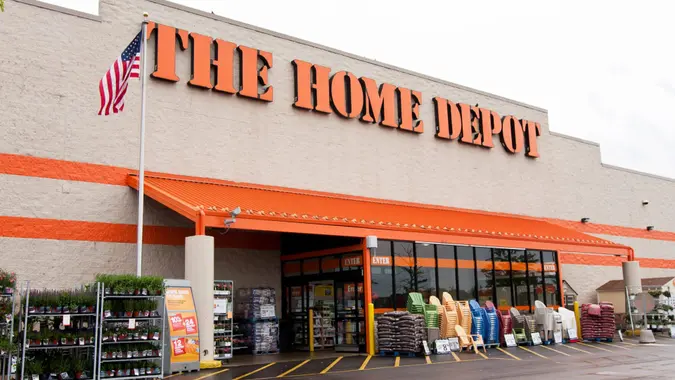How Much Is Home Depot Worth?

Commitment to Our Readers
GOBankingRates' editorial team is committed to bringing you unbiased reviews and information. We use data-driven methodologies to evaluate financial products and services - our reviews and ratings are not influenced by advertisers. You can read more about our editorial guidelines and our products and services review methodology.

20 Years
Helping You Live Richer

Reviewed
by Experts

Trusted by
Millions of Readers
The Home Depot offers customers a convenient way to purchase home improvement tools and supplies from over 2,300 locations in North America. A household name among craftspeople, builders and do-it-yourselfers, The Home Depot often beats its main competitor, Lowe’s, in terms of value. In 2021, Visual Capitalist listed both companies among the world’s most valuable brands, with the Home Depot brand valued at $70.5 billion and Lowe’s valued at $20.7 billion. The numbers listed below can help explain why The Home Depot is so popular.
| About Home Depot | |
|---|---|
| Headquarters | Atlanta |
| Year Founded | 1978 |
| CEO Craig Menear’s Salary (2021) | $1,300,000 base pay |
| What Home Depot Is Worth | |
|---|---|
| Share Price, 52-Week Range | $264.51 – $420.61 |
| 2021 Revenue | $151.157B |
| 2021 Profit | $16.433B |
| GOBankingRates’ Evaluation of The Home Depot’s Net Worth |
$131.454B |
Home Depot’s Market Cap: $336.465B
Market capitalization is determined by the total dollar value of a company’s outstanding shares, which helps investors determine the relative size of a company. Over the past year, The Home Depot’s market cap fluctuated with the number of shares outstanding and the share price. At the current share price of $327.38 as of Aug. 16, The Home Depot’s market cap is $336.465 billion.
Home Depot’s Net Worth: $131.454B
Market caps offer a clear view of what the market values a company at, but that value is also susceptible to change on an almost-hourly basis due to external market forces and investors fighting over the value of shares.
In an effort to bypass market volatility, the GOBankingRates Evaluation calculates a company’s net worth based on recent annual reports of income and profit while also taking into consideration its assets and liabilities.
Based solely on The Home Depot’s revenue and profits from the last three years and its assets and debts, The Home Depot is worth over $131 billion.
The Home Depot’s value rose fairly steadily beginning in 2011, as the housing market recovered from the crash. After a brief dip in March 2020, when the economy shut down due to the pandemic, the share price climbed to an all-time high closing price of about $415 in November 2021, thanks to a strong housing market. Shares have lost about 21% of their value since then and were trading at $327.38 when the market closed on Aug. 16.
In its second-quarter 2022 earnings release on Aug. 16, The Home Depot announced its highest quarterly sales and earnings results in its history, with 6.5% sales growth compared to Q2 2021 and an 11.5% increase in diluted earnings per share. The results beat analyst estimates on both counts, CNBC reported. All 19 regions in the U.S. had positive comparable sales compared to a year ago, and Mexico and Canada had above-average comparable sales.
While seasonal sales failed to meet the company’s expectations in the first half of the year, weakness there was more than offset by better-than-expected sales in project-related categories. Comparable sales were positive across all merchandising departments, with building materials, plumbing, millwork, paint and hardware performing well above company average.
During the earnings call following the release, Home Depot executives told analysts that the company is being challenged by inflation, a tight labor market and supply-chain bottlenecks. Ted Decker, the company’s president and CEO, said, “While the business performed very well and our consumer remained resilient through the first half of the year, we are navigating a unique environment. We can’t predict how the evolving macroeconomic backdrop will impact our customer going forward.” However, Decker acknowledged strength in the “long-term underpinnings of demand for home improvement” and Home Depot’s “distinct competitive advantages” to capitalize on growth opportunities.
Looking ahead to the third quarter, The Home Depot reaffirmed its fiscal year 2022 guidance. The company anticipates 3% sales growth and comparable sales growth and mid-single-digit growth in earnings per share.
Home Depot’s History and Investors
Founders Bernie Marcus and Arthur Blank first conceptualized The Home Depot in 1978 based on their own experience as DIY enthusiasts. After securing the proper financing, they opened the first two stores in Atlanta in 1979, and the company went public in 1981. The Home Depot often contributes to philanthropic causes through The Home Depot Foundation — in particular, projects for veterans that include pledging money to veteran-related causes.
The Home Depot announced in a Jan. 27 press release that CEO Craig Menear would step down from that role on March 1. His replacement is Ted Decker, who joined the company in 2000 and had served as president and chief operating officer since October 2020.
The Home Depot’s investment makeup is similar to its rival Lowe’s. Big banks like Bank of America have a stake in the company, and investment company The Vanguard Group Inc. is — like it is for Lowe’s — The Home Depot’s largest shareholder, with 93,428,756 shares — 9.09% of total shares — as of June 29.
Daria Uhlig contributed to the reporting for this article.
Data is accurate as of Aug. 17, 2022, and is subject to change.
Methodology: The GOBankingRates Evaluation assesses a company’s net worth based on the company’s total assets, total liabilities, and revenue and net income from the last three years. Base value is established by subtracting total liabilities from total assets from the company’s last full fiscal year. Income value is established by taking the average of the revenue from the last three full fiscal years, plus 10 times the average of the net profits from the last three full fiscal years, and then calculating the average of those two figures. The final GOBankingRates Evaluation number is the sum of the base value and the income value.
Our in-house research team and on-site financial experts work together to create content that’s accurate, impartial, and up to date. We fact-check every single statistic, quote and fact using trusted primary resources to make sure the information we provide is correct. You can learn more about GOBankingRates’ processes and standards in our editorial policy.
- The Home Depot. 2022. "HD – Q2’22 Home Depot Earnings Call."
- CNBC. 2022. "Home Depot beats second-quarter earnings expectations, stands by 2022 guidance."
- The Home Depot. 2022. "The Home Depot Names Ted Decker CEO, Effective March 1, 2022; Craig Menear Continues as Chair of the Board."
- Salary.com. "Craig A. Menear."
 Written by
Written by  Edited by
Edited by 

























